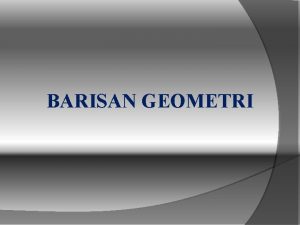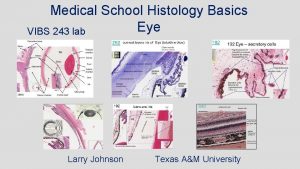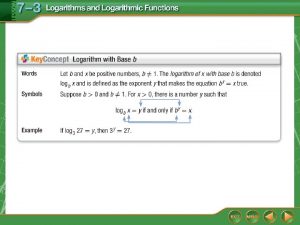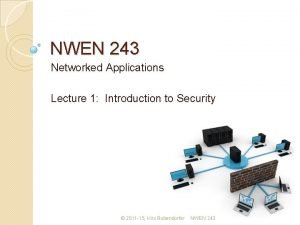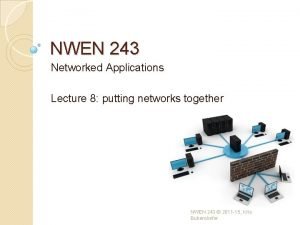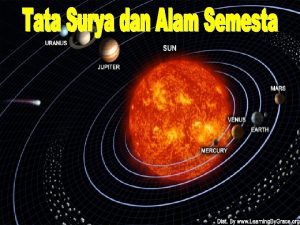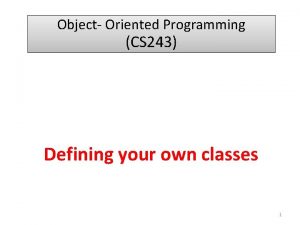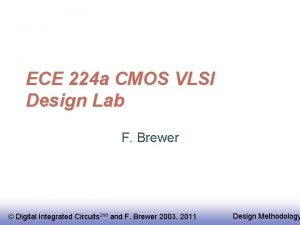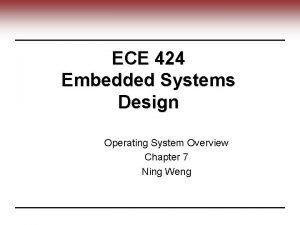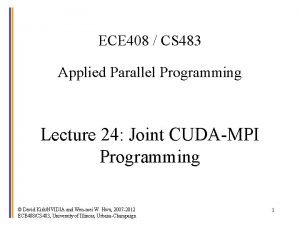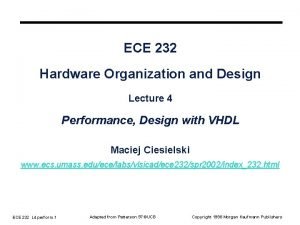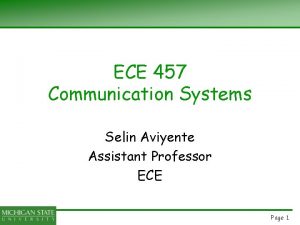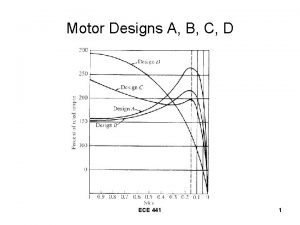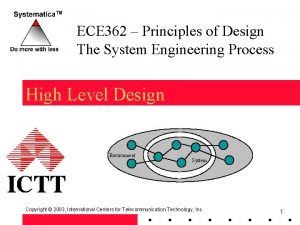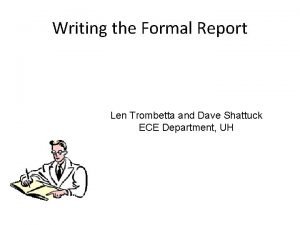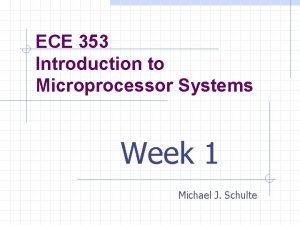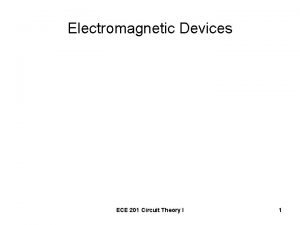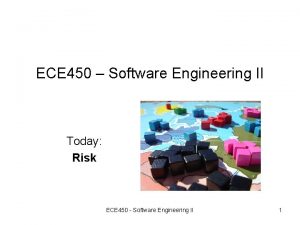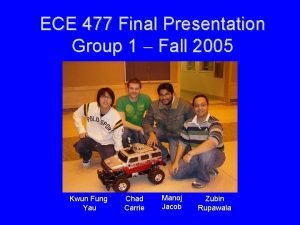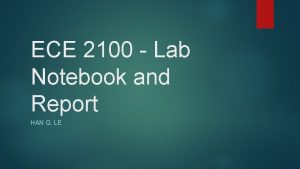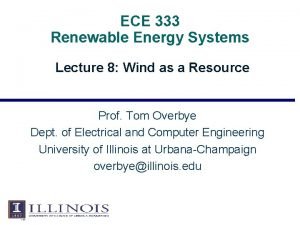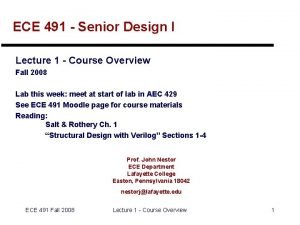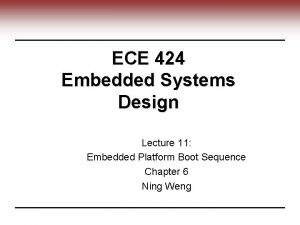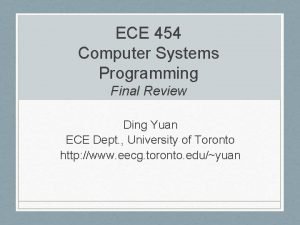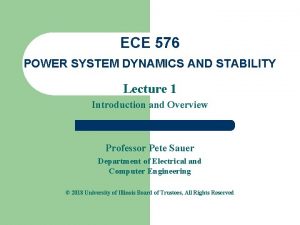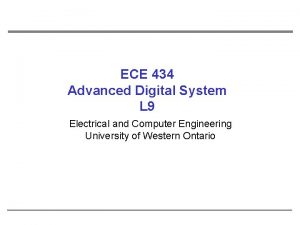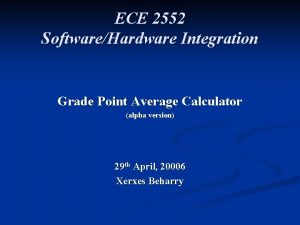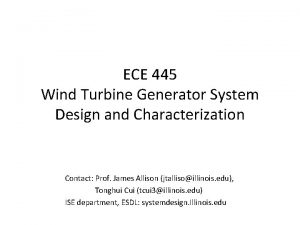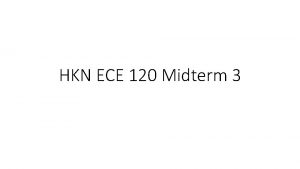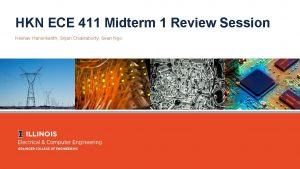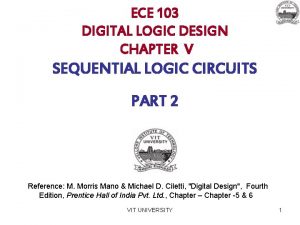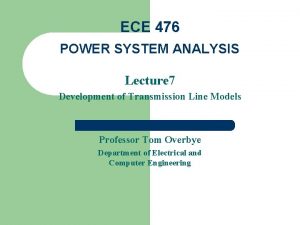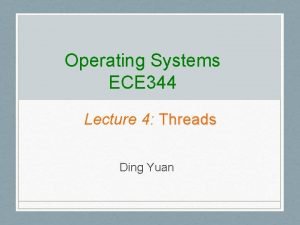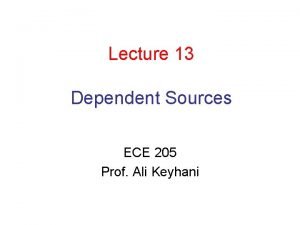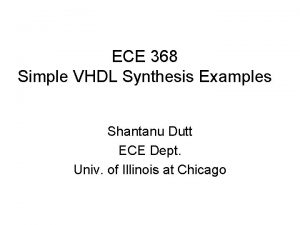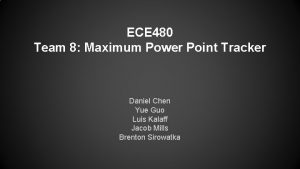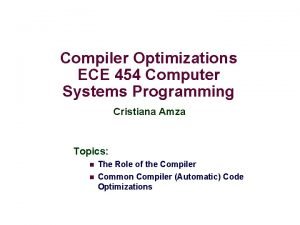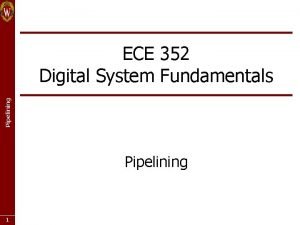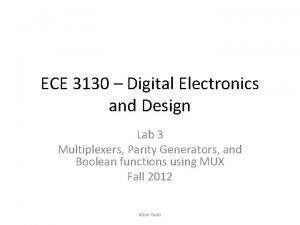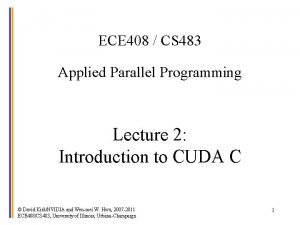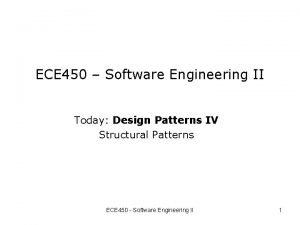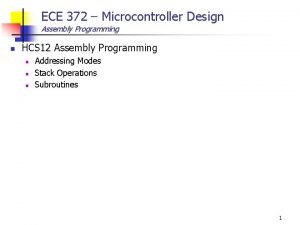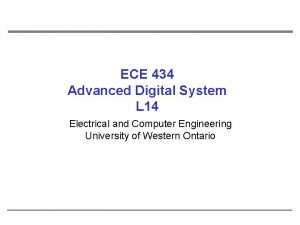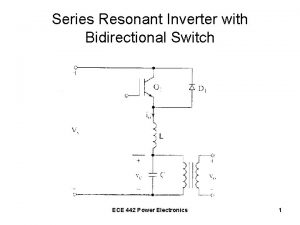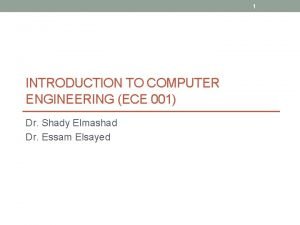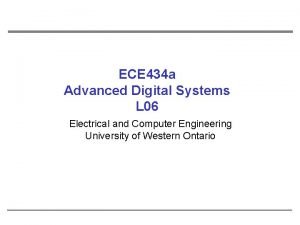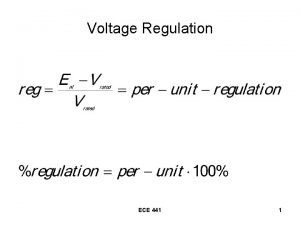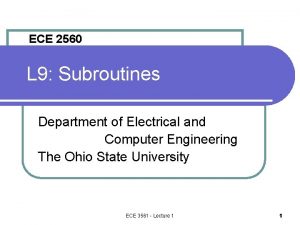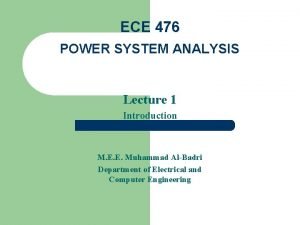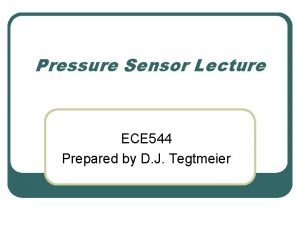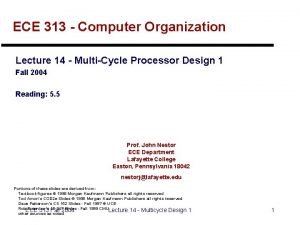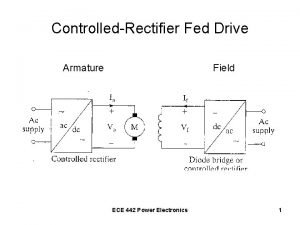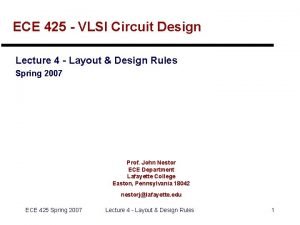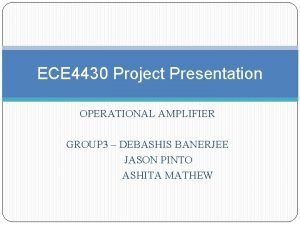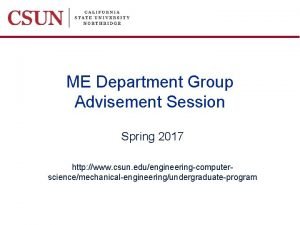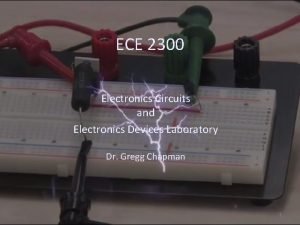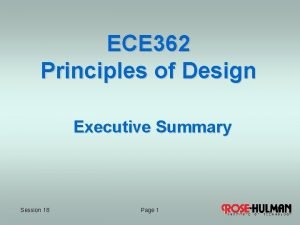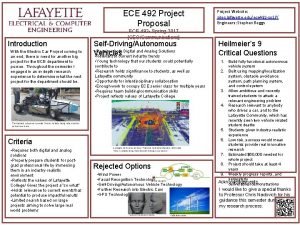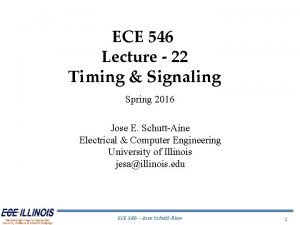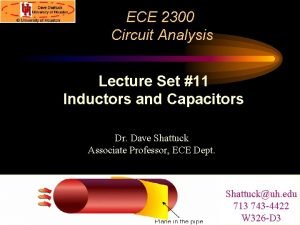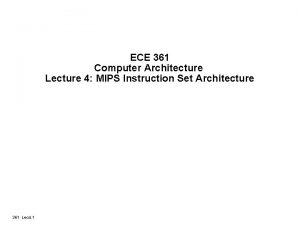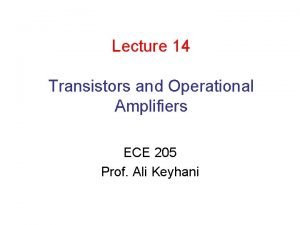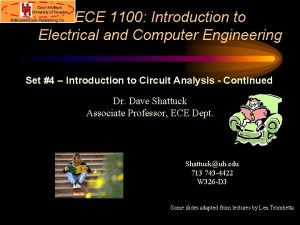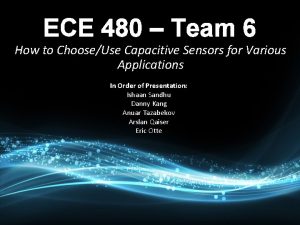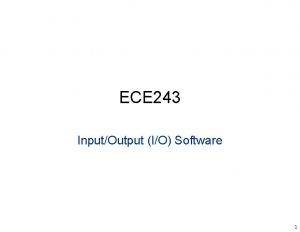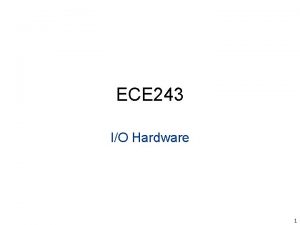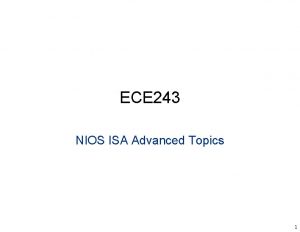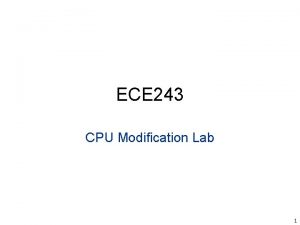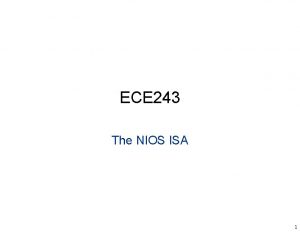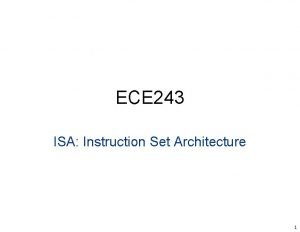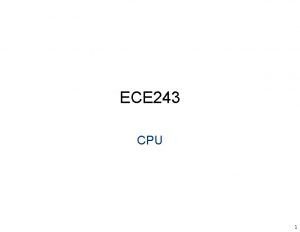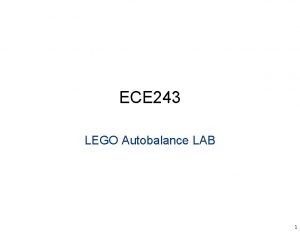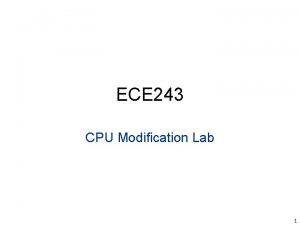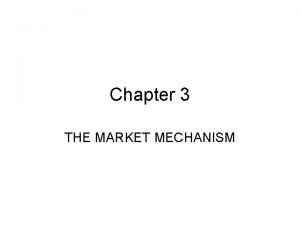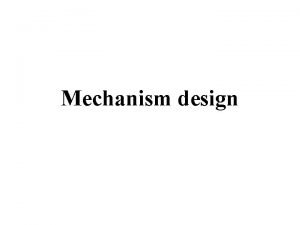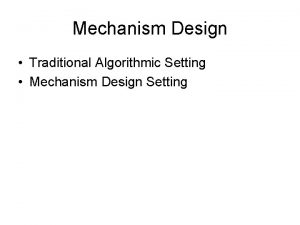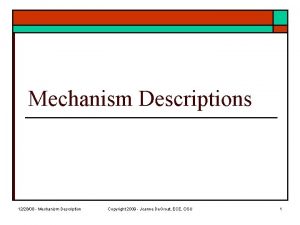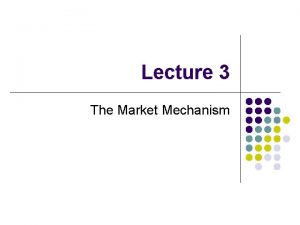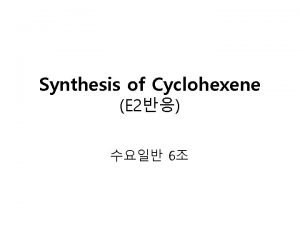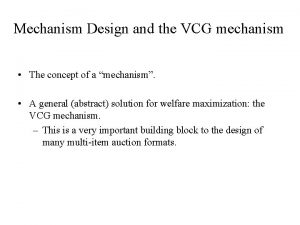ECE 243 Storage 1 Storage A storage mechanism








![Locality Example for (I=0; I<n; I++){ sum+=A[I]); } • What kinds of locality are Locality Example for (I=0; I<n; I++){ sum+=A[I]); } • What kinds of locality are](https://slidetodoc.com/presentation_image_h/246b8aa72932650634d47fd72bf3e1bf/image-9.jpg)





























![Ex: ACCESS PATTERNS • Assume: – – 1 KB direct-mapped 32 B blocks A[i] Ex: ACCESS PATTERNS • Assume: – – 1 KB direct-mapped 32 B blocks A[i]](https://slidetodoc.com/presentation_image_h/246b8aa72932650634d47fd72bf3e1bf/image-39.jpg)




























































- Slides: 99

ECE 243 Storage 1

Storage • A storage mechanism can be two of: – fast – large – cheap • ie. , any given storage mechanism is either: – slow, small, or expensive • Examples: – fast/small/cheap: – slow/large/cheap: – fast/large/expensive: 2

Storage Topics • • Cache Design Memory Design Virtual Memory Disks 3

ECE 243 Caches 4

CACHE • a small, fast storage mechanism • contains a subset of main memory – which subset? • there can be several “levels” of cache – may modern desktops have 3 levels (L 1, L 2, L 3) • caches are “invisible” to ISAs – therefore they are invisible to programs too – you know they are there – but you do not directly manage them (mostly) 5

TYPICAL MEMORY HIERARCHY motherboard CPU Processor chip L 1 cache regs (SRAM) memory L 2 cache disk (SRAM) (DRAM) Larger, Slower, Cheaper • L 1= level 1, L 2 = level 2 • main memory (DRAM) – can be ~1000 X larger than an SRAM cache • DRAM can be ~10 X slower than SRAM • disk can be ~100, 000 X slower than DRAM 6

MEMORY METRICS • latency: – how long it takes from request to response • ie, READ location 0 xabcd – measured in hundreds of CPU cycles • or in tens of nanoseconds • bandwidth: – data transfer rate (bits per second) – impacted by width and speed of buses – eg: DDR SDRAM can do 2. 1 GB/s • data bus: 133 MHz, 64 bits wide 7

WHY CACHES? LOCALITY • tendency: programs tend to reuse data and instructions near those they have used recently • temporal locality: (reuse) – recently-referenced items are likely to be referenced again soon • spatial locality: (nearby) – items with nearby addrs tend to be referenced close together in time 8
![Locality Example for I0 In I sumAI What kinds of locality are Locality Example for (I=0; I<n; I++){ sum+=A[I]); } • What kinds of locality are](https://slidetodoc.com/presentation_image_h/246b8aa72932650634d47fd72bf3e1bf/image-9.jpg)
Locality Example for (I=0; I<n; I++){ sum+=A[I]); } • What kinds of locality are in this code? 9

CACHE REALITY motherboard CPU regs Processor chip L 1 data cache unified L 2 cache memory L 1 inst cache • a typical processor chip – has separate L 1 caches for data and insts • why? – has “unified” L 2 cache which holds both • data and instructions (mixed together) • we’ll focus mainly on L 1 data cache in this lecture 10

CACHE TERMINOLOGY • capacity: how much can the cache hold? (bytes) • placement: where should an item be placed? • Identification: how do we find an item in the cache? • Cache hit: the item we want is present – Hit rate = num_hits / num_accesses • Cache miss: the item we want is absent – Miss rate: num_misses / num_accesses • Replacement: on a miss, we must kick an old item out – to make room for the item we are interested in • Replacement strategy: which item should we kick out? • Write strategy: what happens on a write? 11

HOW A CACHE IS USED • 1) CPU performs a read for address $A • 2) If it’s a “hit” – return the value of location $A stored in the cache – (DONE) • 3) if it’s a “miss” – fetch location $A from mem • 4) place $A in the cache – replacing an existing value • 5) return the value of location $A – (DONE) 12

A 1 -Byte Cache (academic only) 1 -byte cache valid bit V address Data Byte • holds the most recent byte accessed – pretend only byte loads and stores used • how do you know if the cache is empty? – can’t use address==0 x 0 ---this is a valid address! – need a valid bit – V==0 means empty, V==1 means valid • how do you know what byte is in the cache? – must store the address of the byte that is present 13

1 -Byte Cache EXAMPLE Mem: Addr Value Cache: V Addr Data 0 x 3 b 00 0 x 12 … 0 x 0 0 x 5 d 00 0 x 25 … 0 x 0 0 x 7 ac 0 0 x 56 … ldb r 8, 0 x 7 ace(r 0) ldb r 8, 0 x 7 ac 0(r 0) ldb r 8, 0 x 3 b 00(r 0) ldb r 8, 0 x 5 d 00(r 0) 0 x 0 0 x 7 ace 0 x 78 14

HOW CACHES EXPLOIT LOCALITY • cache stores a subset of memory – which subset? the subset likely to be reused – to exploit temporal locality – our 1 -byte cache does this • cache groups contents into blocks – aka “cache lines” – to exploit spatial locality – motivates a “ 1 -block cache” 15

A 1 -Block Cache (academic only) Memory address: t b tag offset Block cache V tag byte B-1 byte 0 Data Block (B Bytes) n offset • holds the most recent block accessed – a block is a group of B consecutive bytes – B = 2 b • how do you know what block is in the cache? – must store the tag of the block that is present – a tag is just a subset of the address bits • how do you access a specific byte in a block? – a portion of the address called the offset – used as an index into the data block 16

1 -Block-Cache EXAMPLE • given a 16 bit addr space • assume little-endian (like NIOS) • assume a 1 -block cache with: – t = 12 bits, b=4 bits 17

1 -Block Cache EXAMPLE Cache: V Mem: Tag Data Addr Value 0 x 3 b 00 0 x 12 … 0 x 0 0 x 5 d 00 0 x 25 … 0 x 0 0 x 7 ac 0 0 x 56 … ldb r 8, 0 x 7 ace(r 0) ldb r 8, 0 x 7 ac 0(r 0) ldb r 8, 0 x 3 b 00(r 0) ldb r 8, 0 x 5 d 00(r 0) 0 x 0 0 x 7 ace 0 x 78 18

REAL CACHE IMPLEMENTATIONS • Store multiple blocks – can cache more data at once • Three main types: – Direct-Mapped • the simplest but inflexible – Fully-Associative • the most complex but most flexible – Set-Associative • the happy medium 19

DIRECT MAPPED • each memory location maps to: – a specific cache location • since cache is much smaller than memory: – multiple memory blocks map to each cache block • for a given memory address: – the set index indicates how to locate a block • since there are multiple blocks in the cache – the offset indicates which byte within a cache block – the tag identifies the block • ie. , which memory location does this block corresponds to? • since several memory locations map to each cache block 20

Direct-Mapped Cache Direct-mapped cache Memory address: Set 0 V tag Data bytes 0. . B-1 Set S-1 V tag Data Bytes 0. . B-1 t s b tag Set index offset • address space size: n – 2 n (bytes) (assuming byte addressable) • block size – B = 2 b (bytes) • number of sets – S = 2 s = the total number of blocks in the cache – ie, there is 1 block per set for a direct-mapped cache • capacity: – B*S = 2 (b+s) 21

Direct-Mapped EXAMPLE • given a 16 bit addr space • assume little-endian (like nios) • assume a direct-mapped cache with: – t = 8 bits, s = 4 bits, b=4 bits 22

Direct-Mapped EXAMPLE Cache: Set V Tag 0 Data Mem: Addr Value 0 x 3 b 00 0 x 12 … … 0 x 0 0 x 5 d 00 0 x 25 12 … 0 x 0 0 x 7 ac 0 0 x 56 … … 15 0 x 0 0 x 7 ace 0 x 78 ldb r 8, 0 x 7 ace(r 0) ldb r 8, 0 x 7 ac 0(r 0) ldb r 8, 0 x 3 b 00(r 0) ldb r 8, 0 x 5 d 00(r 0) 23

FULLY-ASSOCIATIVE CACHE Memory address: t b tag offset V tag Data bytes 0. . B-1 V tag Data Bytes 0. . B-1 Set 0 n • any block of memory can be placed in any cache block – can think of it as one large set • good: more flexible • bad: harder to find a given cache block – must search all of the tags! 24

Fully-associative example • a 16 bit addr space • 16 -byte blocks • total capacity of 64 bytes 25

Fully-associative example Cache: V Tag Data Mem: Addr Value 0 x 3 b 00 0 x 12 … 0 x 0 0 x 5 d 00 0 x 25 … 0 x 0 0 x 7 ace 0 x 78 ldb r 8, 0 x 7 ace(r 0) ldb r 8, 0 x 3 b 00(r 0) ldb r 8, 0 x 5 d 00(r 0) 26

SET ASSOCIATIVE Set 0 Memory address: t s b tag Set index offset V tag Data bytes 0. . B-1 V tag Data Bytes 0. . B-1 Set S-1 n • number of “ways” within a set (W) – say “a W-way set-associative cache” • each block of memory maps to a specific set in the cache – but can map to any block within that set • capacity = B*S*W bytes 27

SET ASSOCIATIVE Example • given a 16 bit addr space • assume a 2 -way set-associative cache • t = 8 bits, s = 4 bits, b=4 bits 28

Cache: Set V SET ASSOCIATIVE Example Tag Data Mem: Addr Value 0 0 x 3 b 00 0 x 12 … 0 x 0 0 x 5 d 00 0 x 25 12 … 0 x 0 0 x 7 ace 0 x 78 15 ldb r 8, 0 x 7 ace(r 0) ldb r 8, 0 x 3 b 00(r 0) ldb r 8, 0 x 5 d 00(r 0) 29

Real life cache Example: • Core 2: • L 1 Data Cache: – 32 KB – 8 -way set-associative • L 2 Cache: – 6 MB – 16 -way set associative 30

COMPARING CACHE TYPES Directmapped Setassociative Fullyassociative Time to access Fast Med Slow Flexibility None Some very 31

What if you write to a cache block? • Option 1: • can pass the write to the next level too – i. e. , to L 2 and/or Memory – This is called “write through” – because the cache writes through to memory 32

What if you write to a cache block? V D tag Data bytes 0. . B-1 V D tag Data Bytes 0. . B-1 • Option 2: – – – Don’t pass the write to the next level only do so when the block is replaced Need a “dirty” bit the block has been written if the dirty bit is 1 This is called “write back” because the cache writes the cache block back later 33

REPLACEMENT STRATEGIES • For fully and set-associative caches: – which cache block do you replace on a miss? • Ideal algorithm: – replace block that will not be used for the longest time – Impossible: must know the future • Realistic algorithm: Least Recently Used (LRU) – Replace the block that has been accessed least recently • Provides a good approximation to the ideal algorithm – each set tracks the ordering of the blocks within it • Each set needs extra bits to store this LRU state 34

LRU IMPLEMENTATIONS V D LRU tag Data bytes 0. . B-1 V D LRU tag Data Bytes 0. . B-1 • num of bits to track LRU for 2 -way set-assoc? • for 4 -way set-assoc? • for N-way set-assoc? 35

Other Replacement Strategies • Random: – pick a random block – works pretty good, fast! • Random-but-not-MRU – used in modern processors – Track MRU • how many bits? Log 2 N – pick a random block • if you pick the MRU block then pick another block – why is this used? • Good compromise: faster than LRU, better than pure random 36

Total Cache Size • total_cache_size = capacity + overhead • overhead = tags + valid_bits + dirty_bits + LRU_bits • Ex: for 32 bit addr space, how many bits for: 37

TYPES OF CACHE MISSES: • cold misses: – the cache is empty when a program starts, all blocks are invalid • capacity misses: – a program accesses much more data than can fit in the cache – ex: access a 1 MB array over and over, when cache is only 1 KB • conflict misses: – a program accesses two memory blocks that map to the same cache block – these two blocks will “conflict” in the cache, causing misses – even though there is spare capacity – more likely to happen for direct-mapped caches 38
![Ex ACCESS PATTERNS Assume 1 KB directmapped 32 B blocks Ai Ex: ACCESS PATTERNS • Assume: – – 1 KB direct-mapped 32 B blocks A[i]](https://slidetodoc.com/presentation_image_h/246b8aa72932650634d47fd72bf3e1bf/image-39.jpg)
Ex: ACCESS PATTERNS • Assume: – – 1 KB direct-mapped 32 B blocks A[i] is 4 B cache is cold/empty for (i=0; i<1024; i++){ sum += A[i]; } 39

Ex: ACCESS PATTERNS • Assume: – – – 1 KB direct-mapped 32 B blocks A[i] is 4 B cache is cold/empty A[i] maps to same set as B[i] for (i=0; i<1024; i++){ sum += A[i] + B[i]; } 40

CACHE PERFORMANCE • Average_ Access_Time = (hit_rate * hit_time) + (miss_rate * miss_penalty) • Cache_hit_time = time for a hit – ex: 1 or 2 cycles for a hit in the L 1 • Miss_penalty = time for a miss – ex: 10 -20 cycles if misses L 1 but hits in L 2 41

Ex: Cache performance • Assume: – a miss rate of 12. 5% – a 1 -cycle L 1 hit latency – a 10 -cycle L 2 hit latency – no access misses the L 2 cache. • What is the average access time? 42

ECE 243 Memory 43

RAM IMPLEMENTATION DETAILS • a simple view of memory: CPU Addr bus MEMORY control data bus 44

A NAÏVE IMPLEMENTATION addr 1 -bit • address in, one bit out 45

A NAÏVE IMPLEMENTATION Location $0? Addr bus 1 0 decoder Mem cell Read/!write Data bus (in/out) • N copies of this circuit for N bits • All attach to the data bus via tristates 46

DESIGNING A BETTER MEMORY innefficient more efficient? addr 1 -bit 47

A 1 Kx 1 bit memory addr 5 bit decoder 10 1 kx 1 Row 0? 32 x 32 memory cell array row addr (ab 9 -5) 5 bits Row 31? in/out Addr bus Ab 9 -0 Sense/write circuits 5 bits Column addr (ab 4 -0) 32 to 1 bidirectional mux Control (read/write, chip select) Data in/out (1 bit) • 1024 bits of bit-addressable storage • most efficient as a 32 x 32 grid (square) • 10 address bits: use 5 addr bits x 5 addr bits to address the grid 48

Combining Memories • Use 8 1 Kx 1 memories to make: – a 1 Kx 8 memory (byte addressable) 1 kx 1 1 kx 1 49

28 -PIN MEMORY CHIP • • A 14 -0: address pins D 7 -0: data pins !CS: chip select: 0=enabled, 1=disabled !WE: write enable !OE: output enable, Vcc: power supply GND: ground 50

CONNECTION WITH A BUS Addr /15 bits Ab 14 -0 A 14 -0 0 !CS M D 7 -0 Db 7 -0 Data /8 bits • how much storage does it have? – 51

Example question • build a 16 -bit-wide data bus? Addr /15 bits Data /16 bits 52

Example Question • build 64 KB of storage (8 -bit-wide bus) – note: 64 KB = 2^16 i. e. , 16 bit addr space /16 bits Addr Data /8 bits 53

AN SRAM CELL (bit line) b !b (bit line) w (word line) • SRAM: Static RAM • READ: set w, “sense” b and !b • WRITE: drive b and !b, then set w to “strobe” in value – == 2 transistors, therefore 6 transistors for a SRAM cell 54

SRAM CELL EXAMPLE: • Write a 1: (bit line) b !b (bit line) w (word line) 55

SRAM CELL EXAMPLE: • Write a 0: (bit line) b !b (bit line) w (word line) 56

SRAM CELL EXAMPLE: • Read (when cell is set to zero): (bit line) b !b (bit line) w (word line) 57

DRAM CELL • 0 or 1 stored in capacitor C • Read: Set word line, look for charge on bitline (sense) – This drains the capacitor a little if it is storing a 1 • Write: – deliver charge on bitline to write ‘ 1’ – drain charge to write‘ 0’ – Then set w to “strobe” in value • must frequently recharge the capacitor (because it leaks) – called “refresh”, must do this for every cell – managed/performed by a dedicated memory controller 58

DRAM CELL EXAMPLE • Write a 1: 59

DRAM CELL EXAMPLE • Write a 0: 60

DRAM CELL EXAMPLE • Read (when cell set to 1): 61

COMPARE SRAM TO DRAM • SRAM: – 6 transistors---expensive – large but fast – no refresh necessary • DRAM: – 1 transistor + 1 capacitor---cheap – small but slower – refresh necessary 62

TYPES OF DRAM • DRAM: – dynamic RAM – asynchronous, needs to be refreshed • SDRAM: – synchronous DRAM • synchronized with a clock signal – Can enter a ‘mode’ to do a “block transfer“ • many bytes with one request from the CPU • DDR-SDRAM: double-data rate SDRAM – Transfer data on both edges of the clock – rather than just the rising edge 63

DRAM REALITY 1: Row/col addrs addr cpu R/W Mem controller request control Memory (DRAM) clock Need a memory controller to manage: the multiplexing of addr bits the refresh process 64

DRAM REALITY 2 • refresh takes time – i. e. , it adds “overhead” • typically must refresh all rows every 64 ms – called the refresh period – eg: spend 2 -4% of each period actually doing refresh • 1. 2 -2. 5 ms of each 64 ms period • cannot do both reads/writes and refresh at the same time – hence memory controller tries to do refresh when nothing else to do 65

DRAM OPTIMIZATIONS • FPM: fast-page mode – Access entire row – rather than each row/column individually • EDO: extended data out – Backwards compatible with FPM – Reduced wait states – optimized handshaking protocol • BEDO: burst EDO – Pipelined, block transfers 66

A ROM CELL: connector • leave connected to store a 0 • disconnect to store a 1 67

TYPES OF ROM • ROM: read-only memory • PROM: programmable ROM – one-time programmable – permanent, by “burning” fuses • EPROM: Erasable PROM – transistors with trapped charge (instead of fuses) – can be erased by UV light • EEPROM: electrically erasable PROM • Flash memory: similar to EEPROM – can read a single cell, but only write blocks at a time • PCM: phase-change memory – future replacement for flash, faster and more-dense 68

Memory Module • Printed circuit board with memory chips on it • Plugs into motherboard socket • Types of modules: – SIMM: Single In-line Memory Module • Usually used in pairs – DIMM: dual in-line memory module • uses both sides of the edge-connector – SODIMM: small-outline dimm • For laptops 69

ECE 243 Virtual Memory 70

OPERATING SYSTEM (OS) • OS is just a program – with special privileges • implements a file system – using hard-drive – which is just another memory-mapped device • manages devices and drivers – so you don’t have to write assembly for I/O • allows multiple programs to share one CPU – Easy: “context switch” • switch between one program and another • copy all p 1’s registers to a struct in memory • copy all p 2’s state from struct in memory to registers – Hard: • allowing p 1 and p 2 to share the same memory 71

HOW CAN MULTIPLE PROGRAMS SHARE ONE MEM? • i. e. , all of your assembly programs start at memory address 0 x 1000000 – they would all overwrite each other! • Solution: have programs use different parts of memory – But how do you decide who is using which part ahead of time? • Answer: you don’t! – Have the system automatically place programs in separate parts of memory 72

VIRTUAL MEMORY (VM) • consider all memory addresses written into programs as “virtual addresses” (VA) – this creates a virtual address space (VAS) • the OS “translates” virtual addrs into “physical addrs” (PA) – physical addrs are used to actually access memory – hardware support helps the OS do this • now multiple programs can use the same VA – but these are translated to different PAs – example: • program 1: VA: 0 x 20000 -> PA 0 x 30000 • program 2: VA: 0 x 20000 -> PA 0 x 40000 73

THREE FEATURES OF VM 1. allows multiple programs to be written using the same virtual addrs 2. provides protection between programs – – program 1 cannot access the physical mem owned by program 2 if it tries, this causes a “segmentation violation” or “segfault” 3. allows a virtual memory address space that is much larger than physical memory – this turns memory into a cache for disk! 74

PAGES • OS manages memory in chunks – called “pages” • pages are normally all the same size – normally in the range of 2 KB. . 16 KB – typically 4 KB for most systems • “page fault” – when a required page is not in memory – must transfer page from disk to memory – Similar to a cache miss 75

VISUALIZING VM (4 K pages) Physical Memory VAS 1 0 x 1000000 app 1: p 1 0 x 0 reserved for OS Hard Drive 0 x 1000 0 x 2000 app 1: p 1 0 x 3000 VAS 2 0 x 4000 app 2: p 1 0 x 1000000 app 2: p 1 0 x 5000 app 2: p 2 0 x 1001000 app 2: p 2 0 x 6000 app 2: p 3 0 x 1002000 app 2: p 3 0 x 7000 76

VM QUESTION • Virtual Memory – effectively turns RAM into a cache for hard drive – with page-sized “cache-blocks” • What is the associativity of this ‘cache’? 77

VM MECHANISMS • MMU: – Main Memory Unit – maps virtual addresses to physical addresses – handles page faults – transfers pages to/from disk 78

Translation • how do we translate from a VA to a PA? – all pages are numbered – translate from virtual to physical page number – offset: • an index for each byte within a page • offset is unchanged by translation (stays the same) Virtual addr: (VA) Virtual page number (VPN) translation Offset (copy) Physical addr: (PA) Physical page number (PPN) Offset 79

TRANSLATION VIA PAGE TABLE • Page table: – a table of physical page numbers (PPNs) – indexed by virtual page numbers (VPNs) – itself sits in memory • Page table entries: – need valid bits – bits for protection (who owns the page) • Steps for a load or store (accessing a VA): – – break VA into VPN and offset use VPN to index page table in mem, get PPN combine PPN and offset to make PA use PA to access memory location • NOTE: every load or store takes two mem accesses! • What if page table entry is invalid? 80

Using a Page Table Virtual addr: (VA) Virtual page number (VPN) Use VPN to index Page table, get PPN Offset (copy) Physical addr: (PA) Physical page number (PPN) Offset Use PA to index memory, perform load/store 81

PAGE TABLE EXAMPLE VAS 1 0 x 0 Page Table VA: 0 x 1000 0 x 1 app 1: p 1 0 x 2 0 x 3 base reg: … 0 x 1000 0 x 2000 app 2: p 1 0 x 3000 app 1: p 1 0 x 4000 0 x 5000 app 2: p 3 0 x 6000 0 x 7000 82

PAGE TABLE EXAMPLE VAS 2 0 x 0 Page Table 0 x 1 VA: 0 x 1000000 app 2: p 1 0 x 2 VA: 0 x 1001000 app 2: p 2 0 x 3 VA: 0 x 1002000 app 2: p 3 … 0 x 1000 0 x 2000 app 2: p 1 0 x 3000 app 1: p 1 base reg: 0 x 4000 0 x 5000 app 2: p 3 0 x 6000 0 x 7000 83

HANDLING A PAGE FAULT • • page faults are handled by the operating system when a page fault occurs: 1. an interrupt is generated, awaking the OS 2. the OS requests the transfer of the page from disk to memory • note: this takes a very long time 3. the OS typically switches to running another program while it is waiting • called a “context switch”---more later 4. the OS is informed (by interrupt) when page transfer is complete • at that point it may return to execution of the original program 84

Page Table Size • assume 4 KB pages, 32 -bit address space • Q 1: how many page table entries are there? • Q 2: How many bits wide is a PPN? • Q 3: How many bytes for the whole page table (excluding control bits)? 85

Translation Lookaside Buffer (TLB) • Page table is quite large – And must be accessed for every mem reference! • Exploit locality: – Only using a small subset of pages at any time – Keep a small cache of in-use page table entries • TLB: – a small, fully-assoc cache of page table entries – integrated into and managed by the MMU 86

Using a TLB Virtual addr: (VA) Virtual page number (VPN) Offset Use VPN to lookup PPN in TLB miss (copy) Use VPN to index Page table, get PPN TLB hit Physical addr: (PA) Physical page number (PPN) Offset Use PA to index memory, perform load/store 87

ECE 243 Disks 88

HARD DRIVES • can store tens to hundreds of GB • on the order of milliseconds to read – 100, 000 X slower than DRAM – 1, 000 X slower than SRAM 89

DISK DATA LAYOUT spindle Tracks sectors Track i gaps • surface of the platter is divided into tracks – concentric rings • each track is divided into sectors – consecutive bits, separated by gaps 90

READING & WRITING Read/write head Air • the platter spins (at a rotational rate, RPM) • read/write head is attached to an arm which moves radially • read/write head magnetizes a thin film on the surface – use two directions of magnetization to represent 0’s and 1’s – sense direction of magnetization to read • head actually “flies” on a cushion of air – similar to flying a 747 6 feet off the ground • in older drives, the head would “crash land” if power was cut 91

DISK ARCHITECTURES • can have one arm with two read/write heads – to read/write both upper and lower surfaces of platter • can have multiple platters and arms • Disk capacity = – #bytes/sector * avg_#_sectors/track * #tracks/surface * #surfaces/platter * #platters/disk • why is there an “average” number of sectors per track? – 92

DISK PERFORMANCE • rotational rate: – speed platter rotates in RPM (rotations per minute) • seek time: – the time it takes to move the arm into position on the right track – depends on the distance between the previous track accessed and the target track – disk makers report Tavg-seek, Tmax-seek • rotational latency: – time it takes for platter to rotate the target sector under the read/write head – depends on the previous position of the platter – disk makers report: Tmax-rotation , Tavg-rotation – Tmax-rotation = 1/RPM * 60 s/min – Tavg-rotation = ½ Tmax-rotation 93

DISK PERFORMANCE • transfer time: – when the head is positioned, time it takes to read/write a sector – Tavg-transfer = 1/RPM * 1/avg_#_sectors_per_track * 60 s/min • Average access time: – Taccess = Tavg-seek + Tavg-rotation + Tavgtransfer 94

EXAMPLE • Assume: – rotational rate = 7200 RPM – Tavg-seek = 9 ms – average_num_sectors_per_track = 400 • compute average access time 95

DISK REALITY • to hide complexity of sectors/tracks/rotation etc: – disk presents view of “logical blocks” – each block is the size of a sector – and numbered 0. . B-1 for all B sectors on the disk • disks must be formatted: – info added in gaps that identify sectors – mark bad sectors • disk connected to the system bus through a “disk controller” – can transfer data in blocks between memory and disk – larger than cache blocks – called DMA “direct memory access” 96

REAL HARD DISK TYPES • ATA/EIDE: advanced technology attachment / enhanced integrated drive electronics – – IDE and ATA are the same thing, IDE is a marketing term Can connect directly to PCI bus Can connect directly to some Pentium motherboards SATA: serial ATA • SCSI: (pronounced scuzzy): – attaches to SCSI bus, can be faster than drives attached to PCI bus • RAID: Redundant Array of Inexpensive Disks – Rather than one big expensive disk, have several inexpensive disks – Can break a single file up (called striping) into parts (called “stripes”) • Put each stripe on a separate disk • Now can read one file faster (read many disks at once) – Can also replicate data on the disks to improve reliability • Ie. , if one disk fails, another is there as a backup 97

OPTICAL DISKS • CDs: Compact Disks – Uses a laser to read indentations (pits) on disk – Disks may contain errors (doesn’t really matter for audio) • CD-ROM: – like a CD, but has error checking (so can use for computer data) • CD-R: (recordable) – can write once by using laser to burn pits • CD-Re. Writable: – can be written multiple times, similar to CD-R • DVD: digital versatile disk: – like CD, but shorter-wavelength laser, smaller pits, more dense tracks • DVD-R: writable DVD • DVD-RW: rewritable DVD 98

Final Note • Flash memory and similar technologies – are quickly replacing hard drives – ex: can buy laptops with flash-like storage • no hard drive – saves power, size, weight • Downside: – flash wears out (current tech) – need clever algorithms to “spread accesses” – system might tell you to replace your drive 99
 Pengertian barisan geometri
Pengertian barisan geometri Jika log 2 = 0 301 dan log 3 = 0 477 maka log 72 =
Jika log 2 = 0 301 dan log 3 = 0 477 maka log 72 = Vibs histology
Vibs histology Perché poseidone perseguita odisseo
Perché poseidone perseguita odisseo P log a = 2
P log a = 2 Art 243 w
Art 243 w Nilai dari ³log 27 adalah
Nilai dari ³log 27 adalah Log3 243=5 in exponential form
Log3 243=5 in exponential form Nwen243
Nwen243 Nwen243
Nwen243 Art 243 kpk
Art 243 kpk Przedszkole nr 243
Przedszkole nr 243 Kod jednoznaczny
Kod jednoznaczny Large vein
Large vein 243 ida
243 ida Cs 243
Cs 243 17 711 04 11
17 711 04 11 Article 243x
Article 243x Cloud infrastructure mechanisms
Cloud infrastructure mechanisms Uses rigid metallic platters
Uses rigid metallic platters Unified storage vs traditional storage
Unified storage vs traditional storage Transferring of data from auxiliary storage to main storage
Transferring of data from auxiliary storage to main storage Primary storage and secondary storage
Primary storage and secondary storage Ece 224
Ece 224 Ece 544
Ece 544 Ece 4 autism
Ece 4 autism Ece 445
Ece 445 Sevicze
Sevicze Ece 408
Ece 408 Uiuc cs 461
Uiuc cs 461 Inseec bordeaux
Inseec bordeaux Ece 232
Ece 232 Ece458
Ece458 Ece
Ece Ece362
Ece362 Ece 2100 uh
Ece 2100 uh Ece 353
Ece 353 Ece 201
Ece 201 Ece malici
Ece malici Ece 450
Ece 450 Ece 477
Ece 477 Ece 2100
Ece 2100 Ece 333
Ece 333 Ece 491
Ece 491 Pattern recognition
Pattern recognition Ece 3340
Ece 3340 Ece 424
Ece 424 Ece 454
Ece 454 Ece fyp
Ece fyp Insertion sort flow chart
Insertion sort flow chart Ece 576
Ece 576 Ece 434
Ece 434 Ece sep
Ece sep Ece gpa calculator
Ece gpa calculator Ece 445
Ece 445 Ece 627
Ece 627 Ece 120
Ece 120 Ece 411
Ece 411 Ece 103
Ece 103 38 mos
38 mos Ece 476
Ece 476 What is thread in operating system
What is thread in operating system 4 types of dependent sources
4 types of dependent sources Ece368
Ece368 Ece tracker
Ece tracker Cristiana amza
Cristiana amza Ece352
Ece352 Ece 3130
Ece 3130 Ece 408
Ece 408 Facade pattern couples a subsystem from its clients
Facade pattern couples a subsystem from its clients Flip flop ece
Flip flop ece Ece 2560
Ece 2560 Ece 372
Ece 372 Ece 434
Ece 434 Ece 442
Ece 442 Ece 191
Ece 191 Ece 434
Ece 434 Ece 391 mp3
Ece 391 mp3 Cwr ece syn
Cwr ece syn Voltage regulation
Voltage regulation Ece 2560
Ece 2560 Ece 476
Ece 476 Ece 544
Ece 544 Ece 313
Ece 313 Fyp methodology example
Fyp methodology example Ece armatür
Ece armatür Ece 425
Ece 425 Ece 4430
Ece 4430 Mse 227 csun
Mse 227 csun Gen.lib.rus.ece
Gen.lib.rus.ece Ece2300
Ece2300 Ece 362
Ece 362 Ece 492
Ece 492 Ece 546
Ece 546 Ece 2300
Ece 2300 Ece 361
Ece 361 Ece 205
Ece 205 Ece 530
Ece 530 Ece 1100
Ece 1100 Ece 480
Ece 480
